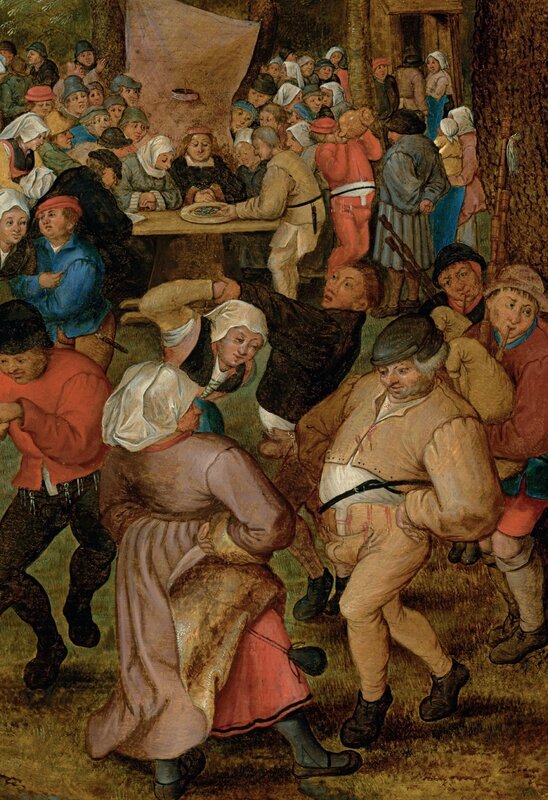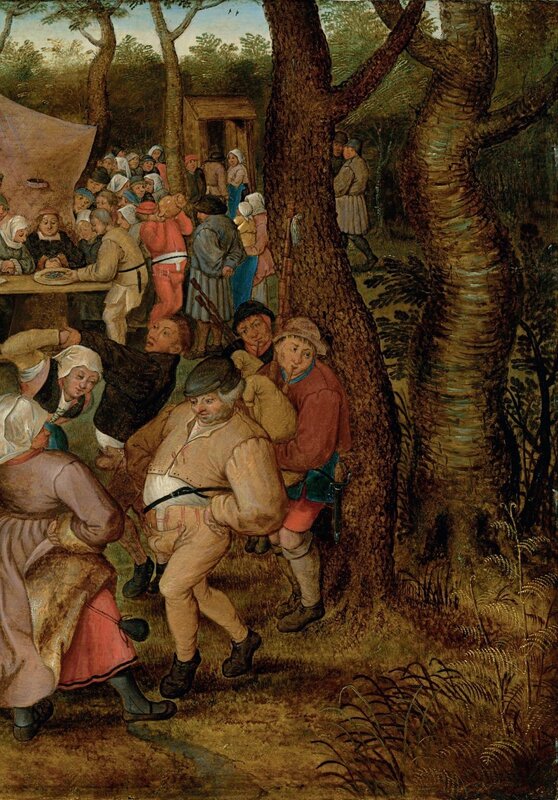Christie's. OLD MASTERS: PART I, 14 April 2016, New York, Rockefeller Plaza
Pieter Brueghel II (Brussels 1564/5-1637/8 Antwerp), The Outdoor Wedding Dance
Lot 133. Pieter Brueghel II (Brussels 1564/5-1637/8 Antwerp), The Outdoor Wedding Dance, signed and dated 'BRVEGHEL · 1615 ·' (lower left), oil on panel, 16 x 22 ¼ in. (40.6 x 56.5 cm.). Estimate $1,200,000 – $1,800,000. Photo: Christie's Image Ltd 2016
Provenance: Private collection, Europe.
Property of a French Private Collection
Note: Previously unpublished and never before offered at auction, this brilliantly colored panel is among the most recognizable images in the history of Flemish painting. The vibrant blues and reds of the paint layer – which remain particularly vivid – lend vital energy to the scene, whose myriad playful details, bawdy humor, and narrative sensibility make it as iconic today as it was in the 17th century. Whirling dancers in the foreground cavort tipsily, enjoying the bagpipe music and festive mood, a few tipping back large jugs of wine for a swig. Some, carried away, embrace amorously, while a few men at left, their backs to the viewer, relieve themselves discreetly at the party’s edge. At center, before a lavender sheet strung up between two trees, is the focus of all this revelry: the bride, sitting beneath a makeshift crown that honors her as “Queen for a Day”, bemusedly watches guests place coins on the pewter plate before her. She is surrounded by eager onlookers, who greedily survey the offerings, and a robed man who diligently records her gifts.
Few details have come down to us regarding the life of Pieter Brueghel II (1564/5-1637/8), who enjoyed a prolific career and early fame, eventually overseeing a thriving atelier in Antwerp which included at least nine pupils. His exact birthdate is unknown, but from later documents historians have extrapolated that he was born in Brussels c. 1564/5. His father was the great Pieter Bruegel I (c. 1525/30-1569), who achieved renown for his revolutionary landscapes and scenes of everyday life in the 16th-century Netherlands. His younger brother, Jan Brueghel I (1568-1625), became a master best known for his elegant, precisely rendered landscapes and floral still-lifes, of which the most celebrated were executed on copper. The Brueghel dynasty carried on well into the 17th century with Jan's son and stepson, the painters Jan Brueghel II (1601-1678) and David Teniers II (1610-1690).
As with many of Pieter II's works, The Outdoor Wedding Dance belongs to a tradition largely established by his father, of which a celebrated example is the Wedding Banquet in the Kunsthistorisches Museum, Vienna. Scholars have long debated how best to interpret such images, discussing them alternately as records of daily peasant life in the 16th-century Netherlands and as genre scenes rife with allegorical and symbolic meanings. While some view the present composition as a straightforward account of a contemporary celebratory event, others focus on its moralizing overtones, which they argue warn against drinking, overindulgence, and lust. Do the figures surrounding the bride, eagerly observing and recording her wedding gifts, provide a realistic glimpse into an outdoor wedding in 16th- or 17th-century Antwerp? Or are their hunched backs and frowning visages meant to warn against the ugliness of avarice? And are the boisterous dancers, whose raucous activities engage our eyes and bring a smile to our faces, intended only to communicate the cheerful mood of the occasion? Or do their suggestive stances and expressions reflect a darker message about human nature? These questions have been asked for generations, and continue to provoke lively debate. They certainly apply to this scene, described by Marlier as "one of the most popular of all subjects in Flemish painting at the beginning of the 17th century," and a high point of Pieter Brueghel II's oeuvre (G. Marlier,Pierre Brueghel le Jeune, Brussels, 1969, p. 188).
Its combination of landscape and genre elements, along with the artist's familiar pathos-imbued depiction of bawdiness in 17th-century life, explain the great contemporary appeal of The Outdoor Wedding Dance. The composition is known in numerous autograph versions, of which the earliest-known are signed and dated 1607 (Walters Art Gallery, Baltimore, inv. 37.364; Musées Royaux des Beaux-Arts, Brussels, inv. 8725). The composition ofThe Outdoor Wedding Dance relates to an untraced drawing or painting by Pieter Bruegel I, known from an engraving by Pieter van der Heyden, published by Hieronymus Cock. A painted panel and a gouache by Jan Breughel I that derive from the same source are also known (Bordeaux, Musée des Beaux-Arts; Paris, Musée du Louvre). Pieter II's works featuring this composition can be divided into two groups: those painted in the same sense as Van der Heyden's engraving, and those in reverse. The present picture, together with the majority of autograph versions, belongs to the latter group, all believed to derive directly from a lost work by Pieter I rather than from the engraving.
One painting by Pieter Bruegel I has been proposed as the inspiration for The Outdoor Wedding Dance (Detroit Institute of Fine Arts, inv. 30.374), after which Pieter II is said to have modeled his highly popular version. However, the composition of the Detroit picture differs in numerous ways from that of the present painting, and is oriented in the opposite direction. Recent research into Pieter II's career has shed light on his working practices: as access to his father's original paintings was not always possible, it seems likely that he often worked from detailed drawings his father had made in preparation for his own paintings. Given the differences between the present Wedding Dance and the Pieter I version in Detroit, it is possible that here Pieter II was working from one of his father's meticulous drawings rather than from the painted panel. Such drawings would have been highly finished compositional studies with annotations indicating the type of brushstroke and colors to be used. For this reason, Pieter II's works after his father's designs often feature certain details evident only in the underdrawing of Pieter I's original paintings.

/https%3A%2F%2Fprofilepics.canalblog.com%2Fprofilepics%2F1%2F0%2F100183.jpg)
/https%3A%2F%2Fstorage.canalblog.com%2F03%2F02%2F119589%2F96711876_o.jpg)
/https%3A%2F%2Fstorage.canalblog.com%2F11%2F31%2F119589%2F94773502_o.jpg)
/https%3A%2F%2Fstorage.canalblog.com%2F20%2F83%2F119589%2F94772815_o.jpg)
/https%3A%2F%2Fstorage.canalblog.com%2F26%2F72%2F119589%2F75604929_o.jpg)
/https%3A%2F%2Fstorage.canalblog.com%2F59%2F60%2F119589%2F26458628_o.jpg)






/http%3A%2F%2Fstorage.canalblog.com%2F19%2F12%2F119589%2F111558062_o.jpg)
/http%3A%2F%2Fstorage.canalblog.com%2F80%2F28%2F119589%2F33193617_o.jpg)
/image%2F1371349%2F20240425%2Fob_c453b7_439605604-1657274835042529-47869416345.jpg)
/image%2F1371349%2F20240425%2Fob_59c6f0_440358655-1657722021664477-71089985267.jpg)